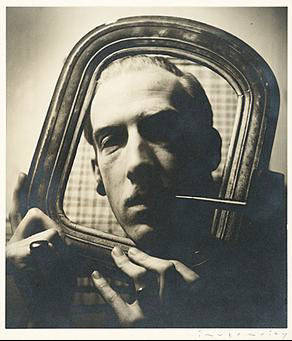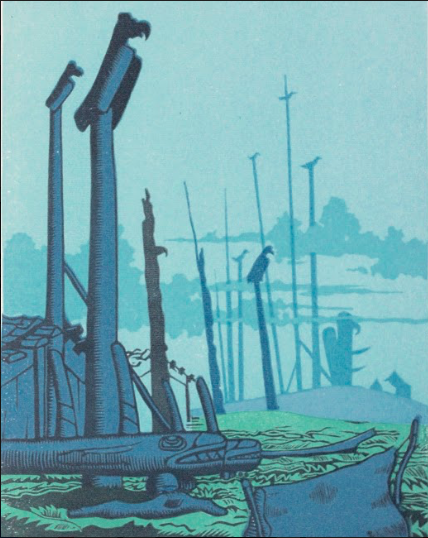Robert Bruce Inverarity, self-portrait, 1938.
Archives of American Art, Smithsonian Institution.
Robert Bruce Inverarity, 1909 - 1999
Robert Bruce Inverarity was a prominent artist, art educator, museum director, author, and anthropologist. He wrote a number of books on the art of the Native Americans of the North West Coast.
Although Inverarity was born in Seattle, Washington, his Canada connection began when the family spent much of Bruce's youth living in Calgary AB, where Inverarity’s father ran a local theatre, and although they moved back to Seattle when Inverarity was a teenager, he would later spend time living, working and exhibiting in Vancouver, BC.
While still attending high school in Seattle, Inverarity shared a studio with Mark Tobey and studied under him for a time. He later took over Tobey’s teaching position at Cornish School of the Arts in Seattle, and then directed the School of Creative Art in Vancouver, Canada. It was at this time that Inverarity hiked the east and west coasts of Vancouver Island, studying the legends of local Indian tribes and collecting artifacts along the way.
It was also during this time that Inverarity regularly showed his artwork. He had a one-man show at Edward Weston's gallery in Carmel, CA, (1929) and another of his paintings at the Blanding Sloan Gallery, (1929), he exhibited with the Brooklyn Society of Etchers, (1931) and had a one-man show at the Hudson Bay Company in Vancouver, BC (1932). His work was shown at Gump's in San Francisco, (1935), and he had a piece exhibited at the New York World's Fair, (1939). He was a member of the Northwest Printmakers Society, the California Watercolor Society, and the Royal Society of Arts, London.
Then suddenly, Inverarity stopped exhibiting his work in 1941, but he continued to create art and pursue photography. Among his best-known works are his portraits of artist friends such as Max Ernst, Mark Tobey, Morris Graves, Marcel Duchamp and Man Ray.
In 1936, he became the state director of the Federal Art Project of the Works Progress Administration. In 1939, he moved from the Federal Art Project to direct the Art and Crafts Project. His leadership in these projects was controversial, as Inverarity had nothing more than a high school diploma, and was criticized for being terribly under-qualified.
However, Inverarity held his position and published several books during this time; Movable Masks and Figures of the North Pacific Coast Indians (1940), followed by Moveable Masks and Figures of the North Pacific Coast Indians (1941), Northwest Coast Indian Art (1946), and The Art of the Northwest Coast Indians (1950).
During World War II, Inverarity served as Chief of Design for Camouflage for the U.S. Navy and then as an Official Navy War Artist (1943-1945).
It wasn’t until after the war, in 1946, that Inverarity finally earned a Bachelor of Arts degree in art and anthropology from the University of Washington. Not stopping there, he went on to obtain both a Master's degree and Ph.D. in fine arts from Fremont University in Los Angeles, where he studied with Hilaire Hiler.
With his fresh credentials, Inverarity’s career as a museum director began in 1949 when he became director of the Museum of International Folk Art in Santa Fe, NM.
In 1954, Inverarity's dismissal from the Museum of International Folk Art caused much controversy in New Mexico and in the museum world in general. Most of the staff resigned in protest, triggering an investigation by the American Association of Museums.
Inverarity rebounded from this setback quickly, and began working as director of the Adirondack Museum in Blue Mountain Lake, NY, he held that position for 11 years, until 1965.
After a period working as an illustrator and designer for the University of California Press, he returned to the East Coast in 1969 to serve as director of the Philadelphia Maritime Museum.
He sold his personal collection of Northwest Coast Indian art to the British Museum's Museum of Mankind in 1975 and retired in 1976.
Inverarity lived in La Jolla, California until his death in 1999.
Selected Collections
The Feckless Collection, Vancouver BC



